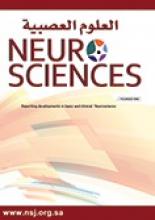Research ArticleOriginal Article
Open Access
Frequency, risk factors, and outcomes in patients with significant carotid artery disease admitted to King Abdulaziz Medical City, Riyadh with Ischemic Stroke
Misealreem A. Shaheen, Areej A. Albelali, Raghad M. AlKanhal, Muneera K. AlSaqabi, Raghad M. AlTurki, Raghad S. AlAskar, Altaf H. Khan and Ismail A. Khatri
Neurosciences Journal October 2019, 24 (4) 264-268; DOI: https://doi.org/10.17712/nsj.2018.4.20190046
Misealreem A. Shaheen
From King Abdulaziz Medical City, MNGHA (Khatri), King Saud bin Abdulaziz University for Health Sciences (Shaheen, Albelali, AlKanhal, AlSaqabi, AlTurki, AlAskar, Khatri), King Abdullah International Medical Research Center (Khan, Khatri), Riyadh, Kingdom of Saudi Arabia.
MBBSAreej A. Albelali
From King Abdulaziz Medical City, MNGHA (Khatri), King Saud bin Abdulaziz University for Health Sciences (Shaheen, Albelali, AlKanhal, AlSaqabi, AlTurki, AlAskar, Khatri), King Abdullah International Medical Research Center (Khan, Khatri), Riyadh, Kingdom of Saudi Arabia.
MBBSRaghad M. AlKanhal
From King Abdulaziz Medical City, MNGHA (Khatri), King Saud bin Abdulaziz University for Health Sciences (Shaheen, Albelali, AlKanhal, AlSaqabi, AlTurki, AlAskar, Khatri), King Abdullah International Medical Research Center (Khan, Khatri), Riyadh, Kingdom of Saudi Arabia.
MBBSMuneera K. AlSaqabi
From King Abdulaziz Medical City, MNGHA (Khatri), King Saud bin Abdulaziz University for Health Sciences (Shaheen, Albelali, AlKanhal, AlSaqabi, AlTurki, AlAskar, Khatri), King Abdullah International Medical Research Center (Khan, Khatri), Riyadh, Kingdom of Saudi Arabia.
MBBSRaghad M. AlTurki
From King Abdulaziz Medical City, MNGHA (Khatri), King Saud bin Abdulaziz University for Health Sciences (Shaheen, Albelali, AlKanhal, AlSaqabi, AlTurki, AlAskar, Khatri), King Abdullah International Medical Research Center (Khan, Khatri), Riyadh, Kingdom of Saudi Arabia.
MBBSRaghad S. AlAskar
From King Abdulaziz Medical City, MNGHA (Khatri), King Saud bin Abdulaziz University for Health Sciences (Shaheen, Albelali, AlKanhal, AlSaqabi, AlTurki, AlAskar, Khatri), King Abdullah International Medical Research Center (Khan, Khatri), Riyadh, Kingdom of Saudi Arabia.
MBBSAltaf H. Khan
From King Abdulaziz Medical City, MNGHA (Khatri), King Saud bin Abdulaziz University for Health Sciences (Shaheen, Albelali, AlKanhal, AlSaqabi, AlTurki, AlAskar, Khatri), King Abdullah International Medical Research Center (Khan, Khatri), Riyadh, Kingdom of Saudi Arabia.
MSIsmail A. Khatri
From King Abdulaziz Medical City, MNGHA (Khatri), King Saud bin Abdulaziz University for Health Sciences (Shaheen, Albelali, AlKanhal, AlSaqabi, AlTurki, AlAskar, Khatri), King Abdullah International Medical Research Center (Khan, Khatri), Riyadh, Kingdom of Saudi Arabia.
MD, FAAN
References
- ↵
- World Health Organization
- ↵
- Zhu C,
- Norris J
- ↵
- Rincon F,
- Sacco RL,
- Kranwinkel G,
- Xu Q,
- Paik MC,
- Boden-Albala B,
- et al.
- ↵
- Rockman C,
- Maldonado T,
- Jacobowitz G,
- Berger J,
- Adelman M,
- Riles T
- ↵
- Eliasziw M
- ↵
- Turan TN,
- LeMatty T,
- Martin R,
- Chimowitz MI,
- Rumboldt Z,
- Spampinato MV,
- et al.
- ↵
- Lanzino G,
- Rabinstein A,
- Brown R
- ↵
- Chatzikonstantinou A,
- Wolf M,
- Schaefer A,
- Hennerici M
- ↵
- al Rajeh S,
- Awada A,
- Niazi G,
- Larbi E
- ↵
- Sacco RL,
- Ellenberg JH,
- Mohr JP,
- Tatemichi TK,
- Hier DB,
- Price TR,
- et al.
- ↵
- Afridi A,
- Afridi Z,
- Afridi F,
- Afridi A
- ↵
- Tan T,
- Chang K,
- Liou C,
- Schminke U
- ↵
- Zafar A,
- Al-Khamis FA,
- Al-Bakr AI,
- Alsulaiman AA,
- Msmar AH
- ↵
- Saber H,
- Amiri A,
- Thrift AG,
- Stranges S,
- Bavarsad Shahripour R,
- Farzadfard MT,
- et al.
- ↵
- Yaqub BA,
- Shamena AR,
- Kolawole TM,
- Patel PJ
- ↵
- El Bcheraoui C,
- Memish ZA,
- Tuffaha M,
- Daoud F,
- Robinson M,
- Jaber S,
- et al.
- ↵
- Alqarni SS
- ↵
- Andersen KK,
- Olsen TS
In this issue
Neurosciences Journal
Vol. 24, Issue 4
1 Oct 2019
Frequency, risk factors, and outcomes in patients with significant carotid artery disease admitted to King Abdulaziz Medical City, Riyadh with Ischemic Stroke
Misealreem A. Shaheen, Areej A. Albelali, Raghad M. AlKanhal, Muneera K. AlSaqabi, Raghad M. AlTurki, Raghad S. AlAskar, Altaf H. Khan, Ismail A. Khatri
Neurosciences Journal Oct 2019, 24 (4) 264-268; DOI: 10.17712/nsj.2018.4.20190046
Frequency, risk factors, and outcomes in patients with significant carotid artery disease admitted to King Abdulaziz Medical City, Riyadh with Ischemic Stroke
Misealreem A. Shaheen, Areej A. Albelali, Raghad M. AlKanhal, Muneera K. AlSaqabi, Raghad M. AlTurki, Raghad S. AlAskar, Altaf H. Khan, Ismail A. Khatri
Neurosciences Journal Oct 2019, 24 (4) 264-268; DOI: 10.17712/nsj.2018.4.20190046
Jump to section
Related Articles
- No related articles found.
Cited By...
- No citing articles found.





